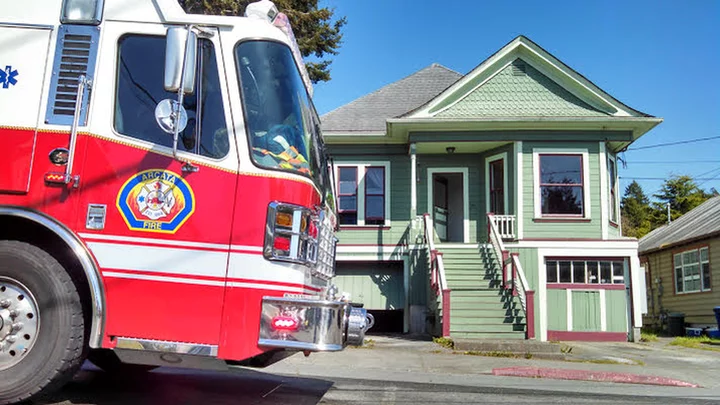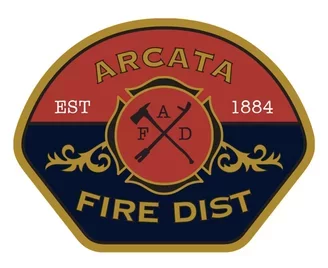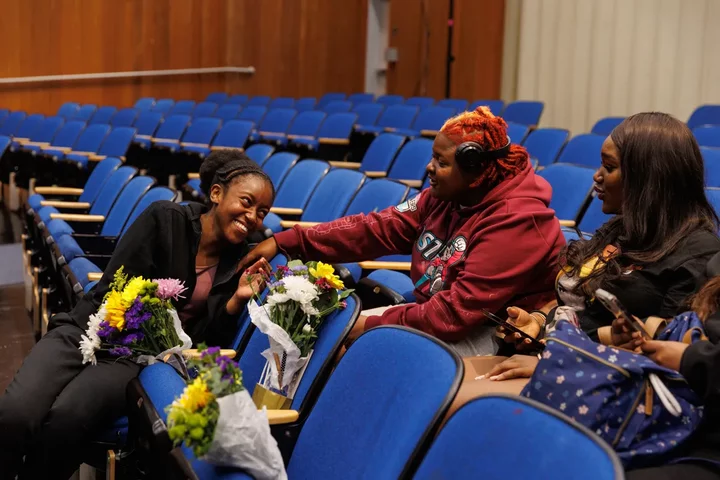(UPDATE: FOUND) Sheriff’s Office Seeks Public’s Help in Locating Missing Trinidad 12-Year-Old
LoCO Staff / Friday, May 17, 2024 @ 3:14 p.m. / Emergencies
The child referenced in the original post has been found safe. In keeping with the Outpost’s policy on missing minors, we have removed the post.
BOOKED
Today: 8 felonies, 11 misdemeanors, 0 infractions
JUDGED
Humboldt County Superior Court Calendar: Today
CHP REPORTS
No current incidents
ELSEWHERE
Governor’s Office: Cannabis crackdown: State officials seize 58,350 illegal cannabis plants worth $57 million in November
KINS’s Talk Shop: Talkshop December 10th, 2025 – Michelle Bushnell
Governor’s Office: Earthquake system shows that failure is Trump’s default setting
Governor’s Office: Federal Court to Trump: keeping a standing army is illegal, the federalization of California’s National Guard must end
The Gateway Area Plan is Moving A Little Fast for Arcata Fire’s Comfort
Jacquelyn Opalach / Friday, May 17, 2024 @ 3:08 p.m. / Fire
File photo.
With the Gateway Area Plan nearing final approval, the Arcata Fire District is worried there won’t be time or money for fire services to expand before shovels hit the ground.
On Tuesday, the Arcata Planning Commission approved a final draft of the Gateway Area Plan, which will rezone a swath of west Arcata to allow high-density housing and mixed-use development. On July 17, the Arcata City Council will hold a second public hearing — the first will be on May 29 — and it might, at that point, finalize work and adopt the plan, which has been in the works for several years.
The plan, paving the way for 3,500 residential units in buildings four to seven stories high, is moving uncomfortably fast for the Arcata Fire District (AFD), which is currently understaffed with just six firefighters and three fire engines.
“The District is asking for a limit on building size until we can play catch up with our staffing and equipment needs that would meet the industry standard,” AFD Deputy Chief Chris Emmons told the Outpost.
“I don’t think anybody’s doing anything wrong, per se. I just think it’s a process where everybody’s following the rules – it’s just the rules are moving faster than we like,” said Emmons, who will step into the fire chief position next month. “It’s kind of the hand we’re dealt, and we have to play within that hand that we’re dealt.”
Alarmed by the speed of the Gateway Area Plan, AFD Board President Eric Loudenslager said he wants to see a policy ensuring that the AFD will get the resources it needs for upcoming development.
“The Fire District does not have the staffing, equipment or training to suppress fires or deal with a major emergency in those taller buildings,” Loudenslager told the Outpost.
“What we’re asking the City to do is actually get out their typewriter and type in, either in policy or in the codes, that they won’t implement the four through seven story floors in the Gateway Area until such time that the City and the District come to consensus,” Loudenslager told the Outpost. On April 9th, Loudenslager sent a letter to Arcata Mayor Meredith Matthews outlining the board’s concerns. You can read it here.
The City, AFD, and Cal Poly Humboldt are working toward a consensus via a standards of coverage analysis, currently underway by an independent contractor. That process, meant to determine what AFD staffing, equipment, training and financial needs will be in the future, is expected to wrap up by the end of the year.
Noting that she isn’t personally involved in the analysis, Arcata Vice Mayor Alexandra Stillman said she believes it will address AFD’s concerns. “As far as I know, there are several solutions available,” Stillman told the Outpost. Iterating that she doesn’t know specifically what those solutions will be, Stillman proposed that collecting developer fees or combining AFD with another fire department like Humboldt Bay Fire could help the situation.
Expansion needs identified in the analysis – which may include renovating and/or expanding stations, hiring and training firefighters, and purchasing ladder trucks – will likely take years to actually secure, Loudenslager said. The unspecific timeline of the Gateway Area Plan makes him uneasy.
“I have no idea when developers will come in, and the City hasn’t really said what they expect,” Loudenslager said. “We need to make sure that the funding track for all the equipment and all the staffing that the Fire District needs is in place.”
Meanwhile, Stillman pointed out that the plan will also take several years to implement, given its scale and the bureaucratic processes involved in development. “We have to relax,” Stillman said. “See what comes forward and don’t get averse – fear averse or risk averse – until we find out what we can do about some of the risks.”
On top of timeline concerns, Loudenslager predicts that the costs of expansion will be immense. “Where that money would come from, I have no idea,” he said. “I don’t think anyone does.”
Funding for the fire department is always tight, Deputy Emmons explained to the Outpost. He noted that the analysis might identify some sources of funding for expansion, including turning to voters.
Meanwhile, Arcata representatives and staff say that the City has worked closely with AFD from the beginning, and plans to continue.
“We’ve been in pretty regular contact with the District staff since the very beginning of the process,” Arcata Community Development Director David Loya told the Outpost. Loya said the City and AFD have worked to confirm fire safety standards in the new buildings and referenced the current Standards of Coverage analysis. “Those are key components to what I view as collaboration with the district.”
Emmons said that the City has been punctual in notifying AFD about deadlines for input. “In my experience, staff-to-staff, when I reach out, they are responsive to us,” he said.
“As long as we’re addressing this ahead of time and not waiting till the last minute, I think everything’s gonna work out well for the community and all the agencies and entities involved,” Emmons said. “I think we’re working that way.”
Board President Loudenslager said he feels disappointed with the City’s response to AFD’s concerns.
“I don’t think the City Planning Commission and the City Council have actually heard us. We’ve spoken, but I don’t think we’ve been heard,” Loudenslager said. “I don’t think they’ve come to grips with the scale of what they’re proposing and how that will affect the District, how it will be funded and how that will be put in place.”
In an email to the Outpost, Mayor Matthews indicated there is still time to find a solution, noting that the City Council has not met to discuss the Gateway Area Plan since the Planning Commission approved it on Tuesday.
“I am meeting with Mr. Loudenslager next week so that I can better understand his concerns in person,” Matthews said. “I have the utmost respect for the AFD and am looking forward to a productive conversation.”
Recreational Fishing on the Klamath and Trinity Shut Down For the Second Consecutive Year
LoCO Staff / Friday, May 17, 2024 @ 1:22 p.m. / Fish
Chinook, from a more abundant time. Photo: NOAA.
PREVIOUSLY:
###
Press release from the California Department of Fish and Wildlife:
The California Fish and Game Commission (Commission) voted unanimously this week to close in-river salmon sport fishing in the Klamath River Basin and Central Valley rivers for the second consecutive year.
As part of its annual process for adjusting seasons and bag limits, the Commission voted to:
- Prohibit the take and possession of Chinook salmon in the Sacramento, American, Feather and Mokelumne rivers and their tributaries.
- Prohibit the take and possession of fall-run Chinook salmon in the Klamath and Trinity rivers and their tributaries.
- Adopt emergency closures of the spring Chinook salmon sport fishing seasons on the Klamath and Trinity rivers and their tributaries.
The regulations are expected to take effect no later than July 1, 2024, following approval by the state Office of Administrative Law.
The in-river closures align with the recommended closure of both commercial and recreational ocean salmon fisheries off the California coast by the Pacific Fishery Management Council due to continued low abundance. Federal fisheries managers have since enacted a full closure of ocean salmon seasons in California. California’s ocean salmon sport fishing seasons and regulations automatically conform to federal regulations unless the Commission acts otherwise.
In other action, the Commission took steps to limit the spread and impacts of chronic wasting disease (CWD) on California deer and elk herds. CWD was confirmed in two California deer for the first time earlier this month. The Commission approved additional changes to regulations governing the importation of cervids (hoofed mammals including deer, elk, moose and reindeer) into California and strengthened disease testing requirements to meet with current U.S. Department of Agriculture standards.
Lastly, the Commission approved regulation changes regarding issuing special hunt permits and drawings. The changes will allow the California Department of Fish and Wildlife (CDFW) to administer and offer the hunts through CDFW’s Automated License Data System (ALDS), ensuring fair and equitable distribution of available permits and reducing barriers to entry into the draw process.
Commission President Samantha Murray along with commissioners Eric Sklar, Darius Anderson and Jacque Hostler-Carmesin participated virtually in the May 15 teleconference meeting. Commission Vice President Erika Zavaleta did not attend.
The meeting agenda, along with supporting documents and background information, is available on the Commission website. Archived video of past Commission meetings is available online. The next Commission meeting is scheduled for June 19-20, 2024, in Mammoth Lakes and via Zoom and phone. An exact location will be determined and updated on the Commission’s website soon.
¿HISPANOHABLANTE? El Lost Coast Outpost Ahora Está Disponible en Español
Hank Sims / Friday, May 17, 2024 @ 10:56 a.m. / Housekeeping
Quick programming note: Sharp-eyed readers may have recently noticed the word “ESPAÑOL” pop up above the text of our blog posts a couple of minutes after they are published.
It looks like this:
That isn’t just a word. It’s a link. If you see it there now, between the headline and the text of this post, give it a click. I’ll wait.
Boom! You’re now reading me in Spanish. Pretty cool, eh?
We recently noticed that ChatGPT has become good enough — and quick enough, and cheap enough — to render our stories in very good Spanish. It understands context and idiomatic expressions far better than previous versions of machine translation could.
Will there be bugs? Probably. Will the translation be worse than I imagine it to be? Possible. Even as I type this I wonder what it’s going to do with “Boom!” and whether or not it will understand what the word “post” in “text of this post” is supposed to mean.
But whether or not, it’s at the very least a half-assed solution for people who prefer to read their local news in Spanish. We hope you find it useful. Feedback welcome.
How will it render “half-assed,” I wonder?
These California Schools Connect Kids to Community Services. Will They Survive Budget Cuts?
Carolyn Jones / Friday, May 17, 2024 @ 7:48 a.m. / Sacramento
Princess Momoh-Danga, left, spends time with friends Jada Lash, center, and Kyyah King, right during an end-of-year celebration for the Sisterhood at Oakland High School in Oakland on May 10, 2024. Photo by Juliana Yamada for CalMatters
Budget cuts may be looming for many California programs, but one multi-billion-dollar initiative has so far evaded the ax: an ambitious push to bring medical and dental care, counseling, parenting classes, cultural activities and other services to public schools.
Gov. Gavin Newsom has so far spared what’s known as the community school initiative, which pairs schools with local nonprofits and other government agencies to provide services to students and their parents. The goal is to transform schools into social service hubs with strong ties to families and the community – an approach that research shows can boost student attendance, reduce suspensions and raise test scores.
Newsom launched the initiative in 2020 with a series of grants totalling $4.1 billion for schools to roll out community school programs over 10 years. About half the money has been spent already, with the most recent grants awarded last week.
Now, amid a steep revenue shortfall in California, the Legislative Analyst’s Office has recommended cutting $1 billion from the remaining funding. Some community school advocates fear the state may slash funding even for schools that are midway through the rollout process. The Legislature has until June 15 to make a decision.
“It is a huge amount of money, but cutting it now would be devastating,” said Anna Maier, a senior researcher and policy advisor at the Learning Policy Institute, an independent think tank that’s researched community schools extensively. “This is an audacious and complicated initiative, and it’s just getting started. We need to keep the momentum going.”
The community school grant money, which so far has gone to more than 1,000 schools, primarily pays for staff: coordinators, tutors, social workers, after-school staff and others. Over time, the programs are intended to be less reliant on state funds as the outside organizations cover more of the costs and schools start billing Medi-Cal for health services.
Nothing new about social services in schools
The idea of schools providing more than just academics has been around for at least a century, as schools during the Industrial Revolution provided meals, clothing and other necessities for students living in poverty. In 1973, the Black Panthers started what’s thought to be a forerunner of modern community schools by opening a school in Oakland that served meals and offered curriculum focused on Black history and culture and other programs tailored to local families.


First: Students hang out at the Shop 55 Wellness Center. Last: Dentist Ann Chen, left, and dental assistant Phuong Truong, right, work on a student patient at the Shop 55 Wellness Center at Oakland High School in Oakland on May 10, 2024. Photos by Juliana Yamada for CalMatters
Informally, many schools in middle-class and affluent areas have been community schools for decades. They’ve built strong relationships with local organizations and businesses, encouraged family involvement and offered a slew of activities suited to their students’ needs. In those neighborhoods, the schools’ success is at least partially due to family support and involvement.
The current push for community schools was spurred in part by a 2017 report from the Learning Policy Institute that found in general, schools that integrate social services “help children succeed academically and prepare for full and productive lives.” Low-income students, students of color, students with disabilities and English learners especially benefited from schools with extra services, parent involvement and strong links to outside organizations.
Pandemic upended community school rollout
But so far, evidence of community schools’ effectiveness in California is uneven — in part because the Covid-19 pandemic upended the education system just as community school programs were getting underway. Oakland Unified, for example, has one of the state’s largest and most comprehensive community school programs, but also has some of the most lackluster outcomes. The suspension rate – 4% last year – has barely changed since 2018 and remains above the state average. The graduation rate actually inched downward last year, to 75%.
Diane Dixon, a Republican assembly member from Newport Beach who sits on the Assembly Appropriations Committee, said she supports community schools generally but is dismayed that test scores for students, especially Black and Latino students, have fallen over the past five years, despite the community school investment. While the pandemic played a role in that decline, she expects better results by now.
“California should have the finest schools in the country, if not the world,” Dixon said. “As legislators, we need to make sure all our children are getting a high quality education, and right now, I don’t know how well we’re doing that.”
Another challenge is accountability. Schools that receive community school grants must report their progress to the state every year and post the reports on their web sites. Nearly all reported their results to the state, but it’s unclear how many schools actually posted those reports publicly. An informal look at a half-dozen districts that received grants showed that none had posted their reports, at least not in an obvious place.
“Community schools give us a chance to address historic inequities. It’s long overdue, but the education system is getting a new mindset, a whole new approach.”
— Asher Ki, director of educational renewal and innovation at Californians for Justice
Schools with poor results are supposed to get assistance from the state, and those who fail to improve risk losing their grants. But the assistance program is still getting underway, and participation is not mandatory.
“Community schools are a great idea, but we need to know what’s working, what’s impactful,” said Kimi Kean, director of Families in Action for Quality Education, which advocates for family involvement in Oakland schools. “This is such a significant investment, we can’t overlook the importance of accountability.”
Angelica Jongco, deputy managing attorney for Public Advocates, one of a dozen organizations that promotes community school policy in California, said the accountability — and results — will improve with time. Schools have only been getting grant money for two years, which is far too soon to expect results.
“Attendance, test scores, suspension rates — these things do not change automatically,” Jongco said. “That’s all the more reason we need to maintain this investment. Especially in times of challenges and uncertainty, we need to be investing in what works.”
‘A whole new approach’
Some schools have shown dramatic progress since winning community school grants. Anaheim High School, for example, since 2016-17 has seen its graduation rate jump 15 percentage points and the number of students meeting California college admission requirements jump almost 40 percentage points, according to state data.
“The community school money has provided services to students who otherwise would not have them. Simple as that.”
— Pamela Moy, oakland high school principal
And hidden within otherwise mediocre data, some schools point to individual success stories. Eureka City Schools, for example, had a high rate of chronic absenteeism last year, but over a 60-day period one homeless student went from 40 absences to just one and another student went from 26 to one. Oakland Unified has seen improvements in the number of students completing the classes required for college admission, as well as a ten-fold increase in the number of students enrolled in college while still in high school.
For Asher Ki, attending a community school would have made all the difference in his education. As a high school student in Fresno in the early 2010s, Ki said he felt “alone and unsupported.” Part of the reason was that his family, who is African American, did not feel welcome and were not engaged.
“For them, school wasn’t a place you wanted to be. It wasn’t where you’d go for a meaningful education,” Ki said. “So they couldn’t help me, because they didn’t know where to go, who to talk to…. Any chance at pushing the status quo was met with racism and dehumanization.”
That experience is what drove Ki to advocate for community schools. Ki is now director of educational renewal and innovation at Californians for Justice, a social justice advocacy group that’s one of a dozen nonprofits that jointly promote community school policy in California. If he had attended a community school, he said, those years would have been much different: He and his family would have had more of a stake in his education.
“Community schools give us a chance to address historic inequities,” Ki said. “It’s long overdue, but the education system is getting a new mindset, a whole new approach.”
Museum visits, health care and more at Oakland High
Oakland High School, a 1,500-student school in Oakland Unified where nearly all students are low-income, receives $360,000 a year in community school state grant money. Among other things, the money pays for museum tickets, yoga classes, college visits, tours of tech companies and other activities for Black girls in a club called Sisterhood.

Members of the Sisterhood club serve themselves lunch during an end-of-year celebration at Oakland High School in Oakland on May 10, 2024. The Sisterhood club is supported by the California Community Schools Partnership Program (CCSPP), which allows the students to participate in activities such as college campus visits. Photo by Juliana Yamada for CalMatters
When Oakland high received its grant, Black girls had the school’s highest suspension rate. The club was a way to help Black girls build friendships, connect to role models and learn about opportunities beyond high school, said principal Pamela Moy.
On a recent Friday meeting of Sisterhood, a few dozen girls shared lunch, chatted about their summer plans and reflected on their year with the club leaders, African American women they referred to as “aunties.” Overall, more than 100 girls have participated in club activities.
Senior Habakkuk Johnson said the club has given girls a place to relax and connect.
“If people come from bad environments, they can come here and be around good people. It helps people do better,” Johnson said. “It helps people change.”
Princess Momoh, a junior, said the club helped her “find Black girls I can relate to. It gave me a chance to talk to more people and make more friends.”

Third-year student Princess Momoh at Oakland High School in Oakland on May 10, 2024. Momoh is a member of the Sisterhood club at Oakland High, which is supported by the California Community Schools Partnership Program (CCSPP). Photo by Juliana Yamada for CalMatters
Since the pandemic, the suspension rate among Black girls at Oakland High has dropped from 13.5% to 9.6% – still high, but a bigger decline than other groups experienced. School counselor Faith Onwusa said she is certain the club is a primary reason for the improvement.
“When I was in school we had nothing like this,” Onwusa said. “It’s just super necessary.”
Community school money also goes toward the school’s wellness center, which offers everything from first aid to mental health counseling to assistance for recent immigrants and their families. The center has more than 40 employees from a variety of agencies, and sees a constant stream of students. Spacious, brightly decorated and always stocked with snacks, the center is an inviting place for students as well as staff. Some students just go there to hang out.
“The community school money has provided services to students who otherwise would not have them,” principal Moy said. “Simple as that.”
###
The Calmatters Ideas Festival takes place June 5-6! Find out more and get your tickets at this link.
CalMatters.org is a nonprofit, nonpartisan media venture explaining California policies and politics.
Should California Doctors Report Domestic Abuse to Police? Here’s How Physician Lawmakers Voted
Ryan Sabalow / Friday, May 17, 2024 @ 7:26 a.m. / Sacramento
Physicians in the California Legislature are divided over a bill that would exempt doctors from a requirement that they report all suspected cases of domestic violence to law enforcement agencies. They would still be required to report suspected child abuse and elder abuse. Photo by Alicia Jucevic for CalMatters.
Should doctors be required by law to notify police immediately if they suspect a patient is the victim of domestic violence?
That question divided three physicians holding seats in the California Assembly when it came up for a vote this week.
Under current law, health care providers face misdemeanor charges if they don’t report suspected abuse to police, even if patients don’t want the police involved.
In recent years some advocates for domestic violence survivors say the mandatory reporting requirements have kept victims from seeking treatment. Advocates say victims fear that if police are called, they will get charged, their children will be taken from them or, in the case of undocumented immigrants, their families will be at risk of deportation.
“We have seen the ways in which the medical mandated reporting requirements for all violent injuries have kept survivors from seeking necessary health care in the first place, made survivors feel like they could never return to health care after they learned of the requirements, or made them feel like they could not share the reason for or the extent of certain injuries or health issues with their provider,” the bill’s author, Democratic Assemblymember Tina McKinnor of Inglewood, told the Assembly Public Safety Committee last month.
Read More: California can take kids from abused moms. Why the separation can harm both
McKinnor’s bill would require doctors and other health care providers to report to police only violence that requires treatment to save the patient’s life. In other suspected cases of abuse, if the patient doesn’t want to report the crime, the health care provider would be required to instead refer the patient to victim-advocate services. The bill still requires doctors to report suspected child and elder abuse.
McKinnor introduced a similar bill last year. It died in the state Senate after passing the Assembly. On Monday, this year’s bill barely made it through the full Assembly. A bill needs 41 votes to pass on the floor. This one had 42.
Democratic Assemblymember Joaquin Arambula, a former Fresno emergency room physician, was one of the 42 lawmakers, all Democrats, who voted for the bill.He told CalMatters on Thursday he voted to support the latest bill because it would require doctors to report life-threatening injuries. The previous bill, which he didn’t vote for, didn’t have that requirement.“I didn’t want to lose that, as we should focus on those who have the greatest risk to life,” he said. “And I believe that this is a good, measured approach.”

Assemblymember Joaquin Arambula speaks to another lawmaker during the Assembly floor session at the Capitol in Sacramento on May 16, 2024. Photo by Fred Greaves for CalMatters.
The other Assembly physician to vote for the bill was Assemblymember Akilah Weber of La Mesa, an obstetrician/gynecologist. She didn’t respond to CalMatters’ interview requests.
Assemblymember Jasmeet Bains, a family doctor from Bakersfield, was among the three Democratic Assemblymembers who voted “no,” along with 12 Republicans.
She told CalMatters Thursday she believes her fellow physicians regularly stop abuse from continuing when they make police reports. She’s worried families will suffer if doctors are no longer required to report.
“I worry about family structures,” she said. “I worry about the environment that children grow up in should perpetrators not be held accountable, because sometimes it’s that one piece that breaks open that circle of violence in homes.”
Twenty-three bipartisan members of the Assembly didn’t cast votes on McKinnor’s bill. Not voting counts the same as voting “no.”

Assemblymember Jasmeet Bains, a Delano Democrat on the Assembly Floor during session at the state Capitol in Sacramento on July 13, 2023. Photo by Rahul Lal for CalMatters.
As CalMatters reported, lawmakers regularly decline to vote to avoid going on record against a controversial bill.
The bill now moves to the Senate. Last year’s bill died after passing the Senate Public Safety Committee.
###
The CalMatters Ideas Festival takes place June 5-6! Find out more and get your tickets at this link.
CalMatters.org is a nonprofit, nonpartisan media venture explaining California policies and politics.
UH OH: More Than 100 Individuals in Humboldt Exposed to Measles Last Week (But Most are Likely Immune, Says DHHS)
LoCO Staff / Thursday, May 16, 2024 @ 4:22 p.m. / Health
Humboldt County Department of Health & Human Services press release:
Public Health staff have been in contact with at least 109 people who were exposed to measles after an individual with the virus visited two Eureka locations late last week and is asking anyone who thinks they may have been exposed, but has not been contacted, to call 707-268-2182.
Through interviews, vaccine records and in some cases immunity testing, the majority of those who were known to be exposed are likely immune to measles, and 10 individuals were given the post-exposure prophylaxis vaccine which can be given up to 72 hours after exposure.
On Friday, May 10, the Humboldt County Department of Health & Human Services issued a news release informing the community that individuals who visited the Days Inn by Wyndham, 270 Fifth St. in Eureka from Thursday, May 9, at 2 p.m. through Friday, May 10, at 3 a.m. or the Providence St. Joseph Hospital Emergency Department, 2700 Dolbeer St. in Eureka Friday, May 10, between 2:30 a.m. and 6:30 a.m. may have been exposed to measles.
If you were inside of either of these locations during the times mentioned and have not been in contact with Public Health staff, please call 707-268-2182, whether or not you are experiencing symptoms. A Public Health nurse will evaluate your possible exposure, help determine your immunity status, and provide additional information.
Anyone who contracted the virus after last week’s exposure would start to be contagious anywhere from early Friday morning through May 31. If you think you may have measles, contact your primary care provider or Public Health. Do not physically go into a medical facility.
According to the California Department of Public Health, measles is a highly contagious virus that lives in the nose and throat mucus of an infected person. It can spread to others through coughing and sneezing. The virus can live for up to one hour in an airspace after the infected person leaves the area, and other people who breathe the contaminated air or touch the infected surface, then touch their eyes, noses or mouths can become infected.It can take anywhere from 7 to 21 days to develop symptoms after exposure to measles, and symptoms usually begin with a fever that lasts for a couple of days, followed by a cough, runny nose, conjunctivitis (pink eye) and a rash. The rash typically appears first on the face, along the hairline and behind the ears and then affects the rest of the body. Infected people are usually contagious from about four days before their rash starts to four days afterward. Children under 5 years old and people who are pregnant or have compromised immune systems are at highest risk for severe disease and complications from measles.
Measles is a vaccine-preventable illness. The measles, mumps and rubella (MMR) vaccine is 97% effective at preventing illness. For more information about the vaccine, contact your primary care provider and visit cdc.gov/measles/vaccination.html.
Most children and young adults’ digital vaccination records are available through the California Department of Public Health’s Digital Vaccine Record: myvaccinerecord.cdph.ca.gov.







